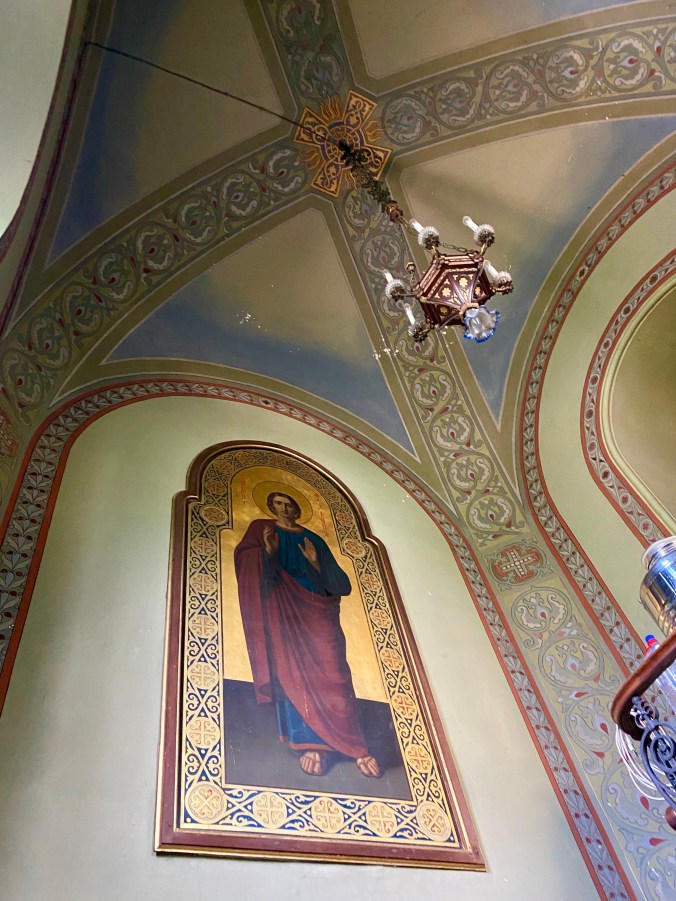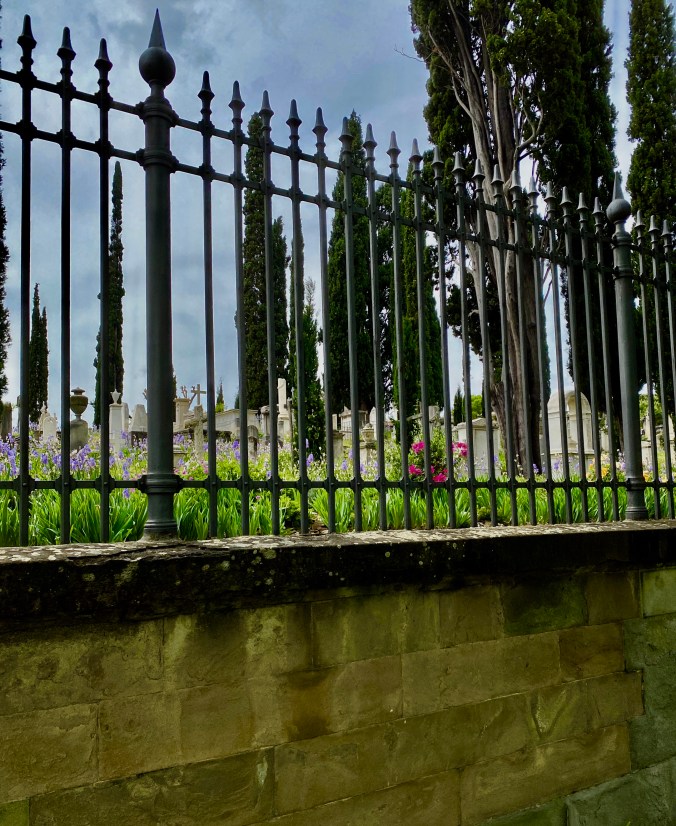I have the good fortune to live 2 blocks from this gorgeous landmark. It is almost never open for visits, but I got lucky and snagged a ticket for a rare tour recently.


Known as the Church of the Nativity of Christ and St. Nicholas the Wonderworker (Chiesa della Natività di Nostro Signore Gesù Cristo e San Nicola Taumaturgo), The Russian Orthodox church is located on via Leone X. Its style is a late 19th and early 20th century imitation of the earlier Naryshkin Baroque.
By the end of the 19th century, there was a small but elite Russian colony in Florence. Their much desired permanent place of worship came to fruition between 1899 and 1903. It was the first Russian Orthodox church to be built in Italy and was designed by Russian architect Mikhail Preobrazhensky (1854–1930), who had trained at Moscow’s Academy of Arts, and was erected under the supervision of Italian architects Giuseppe Coccini (1840–1900) and Giovanni Paciarelli (1862–1929). The church is a fine combination of Russian and Italian artistry.

The church is topped with one large central onion-shaped dome and four smaller ones, all covered with bright turquoise, green and white scales of majolica (manufactured by the Cantagalli factory of Florence) and topped with gilt crosses and chains. Laid out in the form of a Greek cross, the church grounds are surrounded by an iron railing fence with three monumental gates decorated with the double-headed imperial eagle and Florentine lily forged by the Michelucci foundry of Pistoia.

The church itself, constructed in red brick and grey stone (pietra Serena) from quarries near Fiesole, is decorated with 52 semi-circular or ogival arches known as kokočniki (named after the traditional Russian female headdress) and featuring six winged cherubs, like those of the Cathedral of the Resurrection of Christ in St. Petersburg.
Above the doorway, a canopy houses a Venetian-made mosaic icon of “Znamenie,” the mother of God, between stems of flowering lilies. On the north and south sides of the church, two other tabernacles house mosaics of the Peter and Paul.
The splendid wooden entrance door, which came from the private chapel at Villa Demidoff at San Donato, was inspired by Ghiberti’s Gates of Paradise. Depicting 22 scenes from the Old Testament, it had won its creator Rinaldo Barbetti first prize in a national exhibition in Florence in 1861.


True impetus was given to the church-building project when Archipriest Vladimir Levitsky (1840–1923) arrived in Florence in 1878. Despite many setbacks regarding, for instance, the designation of the land where the church should be built, Levitsky persevered and, in 1890, travelled to St. Petersburg to present the procurator-general of the synod with drawings prepared by the chosen architect, Preobrazhensky. A decree authorizing the construction of the church was issued in May 1891, but it took another seven years before the Russian Ministry of Foreign Affairs finally gave its permission.















Typical of Orthodox churches in northern Russia at the time, the Florence church was built on two storeys: the lower church, designed to be warmer in winter, was dedicated to Saint Nicholas, in memory of the Demidoff chapel. The upper church, cooler in summer, was dedicated to the Nativity and features a magnificent marble iconostasis with icons of the patron saints of the imperial family gifted by the assassinated Tsar Nicholas II, a martyr of the Orthodox Church.






























Here’s the article from Wikipedia:
Nicholas I of Russia’s daughter Grand Duchess Maria Nikolaïevna first had the idea of building a church for Florence’s Russian community in 1873, but it was only six years later that a large gift from prince Paul Pavlovitch Demidoff of San Donato allowed construction to commence. Pietro Berti was initially taken on to design it by archpriest Vladimir Levitsky, then curate of the Orthodox church at the Russian embassy. However, he later switched to the Russian academician Mikhail Preobrazhensky and the Florentine engineer Giuseppe Boccini.
Preobrajensky’s first designs of 1883-85 were too ambitious, so a temporary church was built on a site acquired by the embassy. This became the parish church in 1888. Levitsky eventually raised enough funds to build a permanent structure and in 1897 the Russian ambassador and foreign minister approved plans produced in 1890 by Preobrajensky.
The first stone was laid on 28 October 1899 at a ceremony attended by count Caracciolo di Sarno, prefect of Florence, general Antonio Baldissera, the Russian ambassador Aleksandr Nelidov and consul general Tchelebidaky.
The lower part of the church (dedicated to St Nicholas the Wonderworker) was consecrated on 21 October 1902 and the upper church (dedicated to the Nativity of Christ) was consecrated on 8 November 1903. However, the building as a whole was only fully completed the following year.
After the 1917 Revolution the church in Florence lost Russian state support and in 1921 it became independent from the church back in Russia despite attempts by Soviet diplomats to claim ownership of the building. From 1920 onwards it was under the jurisdiction of Eulogius and in February 1931 it joined the jurisdiction of the Archdiocese of Russian Orthodox churches in Western Europe.
Constantine I of Greece died in exile in Palermo on 11 January 1923 and later that year he was buried in the church, followed in 1926 by his mother queen Olga Constantinovna of Russia and in 1932 by his widow Sophia of Prussia. All three sets of remains were moved to the Tatoi Palace in Greece in November 1936, a year after the restoration of the Greek monarchy.





To visit the church, it is necessary to make an appointment. For further information call +39 055 477986.












































































































You must be logged in to post a comment.